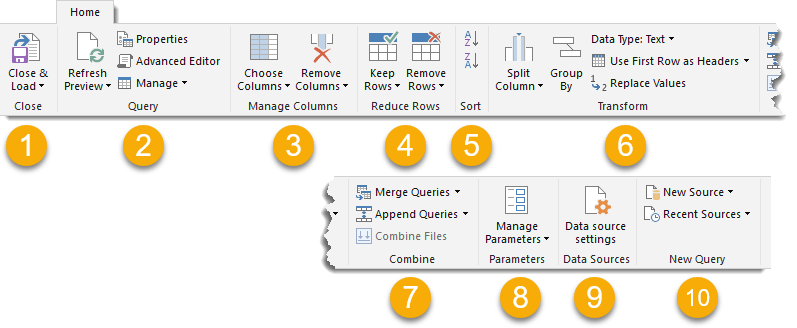

- #USING QUERIES IN EXCEL 2016 UPDATE#
- #USING QUERIES IN EXCEL 2016 FULL#
- #USING QUERIES IN EXCEL 2016 DOWNLOAD#
- #USING QUERIES IN EXCEL 2016 FREE#
Let us know if you found these tips useful! Hopefully, we helped simplify your workflow and saved you some extra time.Ĭheck out our Data Collection and Transformation page for more information, and feel free to contact us if you require help or support with any of your analytics challenges.
#USING QUERIES IN EXCEL 2016 UPDATE#
To update the file as you receive more data, simply:Ī. You now have all the data combined into one file!ġ0.
#USING QUERIES IN EXCEL 2016 DOWNLOAD#
If youre using Excel 2010/2013, download the Microsoft Power Query. Choose where you want the new table to load (In this example, the data will be loaded to a PivotChart, but you can load yours to wherever you need it) Excel 2016s new Get & Transform tool allows you to extract data from a Table and. Remove all columns apart from Date and SessionsĨ. You can now perform any extra data transformation steps that you may want to apply to the data before it’s loaded into your new master fileī. You’ll now be taken to the Power Query window, where a number of steps will have been automatically added to combine the files. Check that Power Query has correctly interpreted the sample data file shown, and tweak any settings if necessary, then click OKħ. Enter the file path of the folder where you’re collecting the input data files, or find it via the Browse toolĦ. Data > Get Data > From File > From FolderĤ. Open up the workbook in which you want to combine the data (we’re using a new blank workbook for this example)ģ. Get your data files in the same folder (it’s easiest if these are the only files in the folder)Ģ. Undo support Refresh and Edit Query operations on queries can be undone. No complex activation The Get & Transform group is visible and active by default on the Data tab. In Excel 2016 we integrated the Power Query technology and experience into Excel. Check that all the files you want to combine are in the same format (column names etc.) If they aren’t in the same format, there are ways to rectify this in Power Query, but for the sake of brevity they won’t be discussed in this article.Ĭ. The Power Query technology is now available as part of Excel 2016, so you can rely on everyone using Excel 2016 to have it and be able to consume your workbooks. Creating and using Dynamic Query Parameters as a Filters in Power BI. Select the worksheet, and then add the fields you need to the right panel (click on the arrow in the middle) If you cannot see the Worksheet names, click on Options button and check System Tables check box. You can select Workbook that you are currently opening > OK.

It can also be installed as a free add-in if you use Excel 2010 or Excel 2013, but some of the following steps will differ slightly.ī. Select the workbook that contains the data. Power Query is a built-in feature of Excel 2016 and onwards, which is what we’ll use for this walkthrough. Advanced data model support with Power Pivot includes a dedicated data modeling editor, a data view, DAX calculated columns, KPIs, and hierarchies.A. In addition to the basic analytics features, you can use Power Query to import, shape, and merge data from corporate, big data, and cloud data sources, and share queries. Basic data model support allows you to load data to the data model, detect relationships automatically, add time grouping, and create DAX measures.įor more information about obtaining the best performance, see Choose between the 64-bit or 32-bit version of Office.Īdvanced analytics features are available with Microsoft 365 Apps for enterprise, Office 2019 Professional, Office 2019 Professional Plus, and Excel 2019 standalone one-time purchases. With Power Query, you can import, shape, and merge data from files, databases and websites.

The 'Choose Data Source' dialog box appears. Click From Other Sources, From Microsoft Query. On the Data tab, in the Get & Transform Data group, click Get Data. Such features include PivotTables, slicers, charts and data model capabilities. With Microsoft Query, you can select the columns of data that you want and import only that data into Excel. See the details below for more information on Power Query and Power Pivot availability and ask your IT team if your current Office plan supports these features.įor more information, see Microsoft 365 Apps for enterprise.īasic analytics features are available with any Microsoft 365 subscription or any Office 2016 one-time purchase. Select the desired text file and click on Import. Once we have selected the Text/CSV file option, an ‘Import data’ dialog box is opened.
#USING QUERIES IN EXCEL 2016 FULL#
With Microsoft 365 Apps for enterprise, the Excel app on Windows for PCs offers the full Power Query and Power Pivot features that further enhance your analytics and modeling capabilities, take advantage of advanced data connectivity options, and effectively share your data across the organization. Follow the steps to import a text file using Power query: Click on the Data tab -> Text/CSV File.


 0 kommentar(er)
0 kommentar(er)
